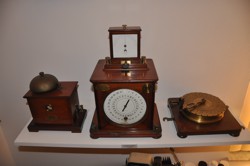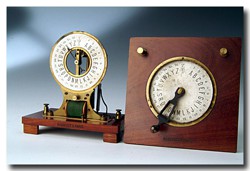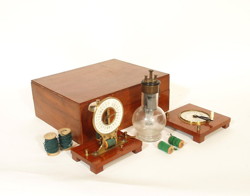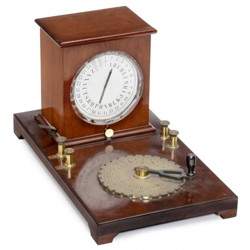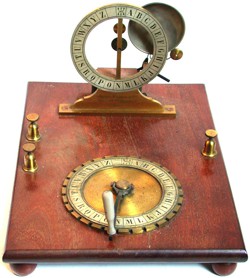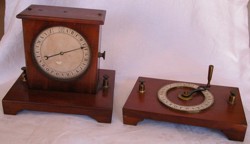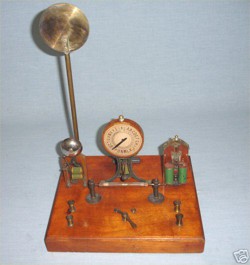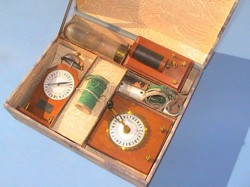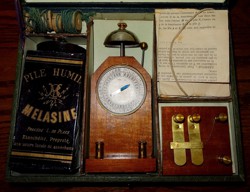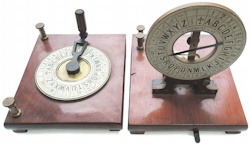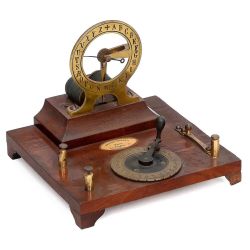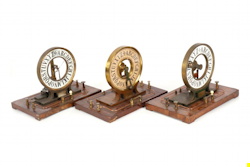Dial Telegraph Systems
In the late 1840's, the French watchmaker Louis-Francois Breguet developed a unique new dial telegraph system. This system consisted of 2 main components; a transmitter and a receiver.
The transmitter consisted of a large metal disk mounted on a wooden base with the letters of the alphabet and numbers stamped along the outer edge. At the center of the disk was a cranking handle connected to a switch. As the handle was rotated, the switch opened and closed as each letter/number was passed.
At the other end of the telegraph line was the receiver, which was a large wooden box with a paper dial in the middle. The dial also had the letters of the alphabet and the numbers printed along the periphery. At the center of the dial was a rotating needle.
When the operator rotated the handle on the transmitter, the opening and closing of the switch caused the needle on the receiver to rotate in step wih the transmitter handle. So when the transmitter handle pointed to a specific letter or number, the needle on the receiver would point to the same letter or number.
One advantage to this system was that there was no need for the operators to learn Morse Code. They could simply read the desired text directly from the receiver dial.
At the end of the message the transmitter and receiver would have to be returned to the designated starting point before the next message was sent.
In addition to the transmitter and receiver, there was a bell box at the receiving end which would ring a bell and display a letter "R" in a small window on the box to indicated a message was about to be sent.
The French dial telegraph system was very popular in the 1850's and its use continued at least into the 1870's.
Detailed photos of the dial telegraph components can be seen below:
(Click on the pictures below to see larger versions of the photo)
A complete French Dial Telegraph consisting of transmitter, receiver, bell box and galvanometer. The transmitter is made by Breguet, while the other components are made by Vinay. Ca. 1850's.
Breguet Dial Transmitter
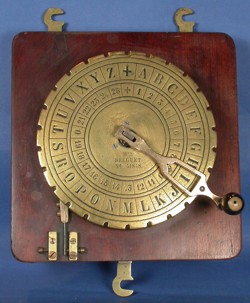 |
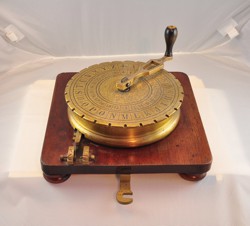 |
|---|
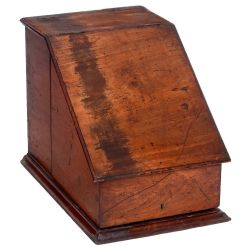 |
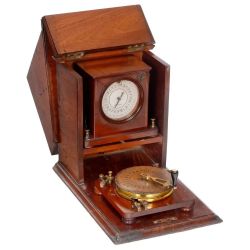 |
Breguet Dial Telegraph set in portable carrying case.
Vinay Dial Receiver
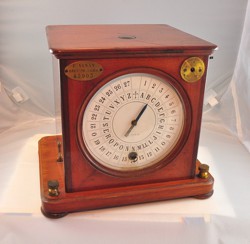 |
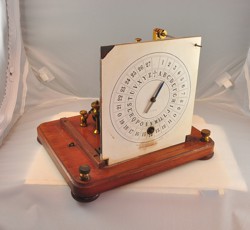 |
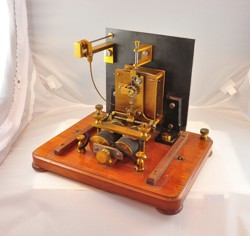 |
|---|
Vinay Bell Box
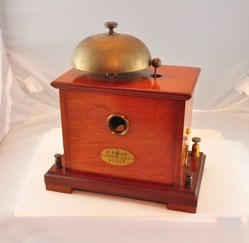 |
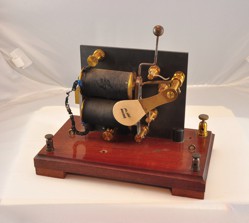 |
|---|
Digney-Chambrier Dial Telegraph. Ca. 1860
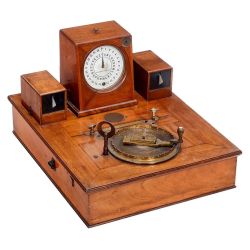 |
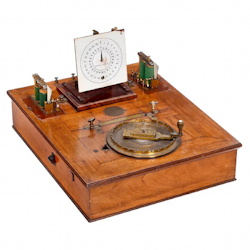 |
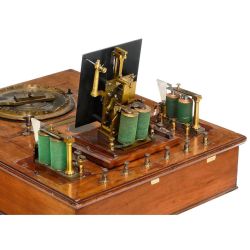 |
Very Early Breguet Combination Dial Transmitter & Receiver. Ca. 1850 (Based on the Original Breguet Dial Telegraph Patent)
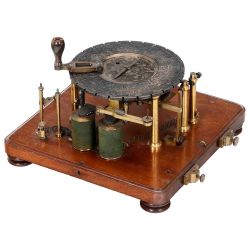 |
 |
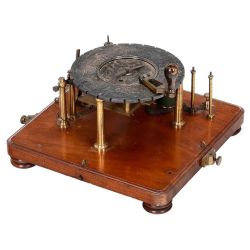 |
Breguet & Crossley Portable Dial Telegraph Set
This portable dial telegraph set was invented by M.L. Breguet (Paris) and Louis J. Crossley (Halifax, England) in 1854. It has the Receiver, Transmitter, and Alarm Bell in separate compartments inside a mahogany box.
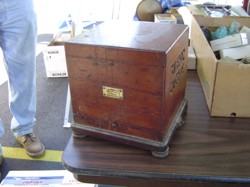 |
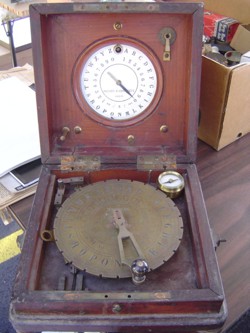 |
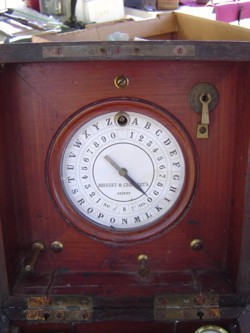 |
|---|---|---|
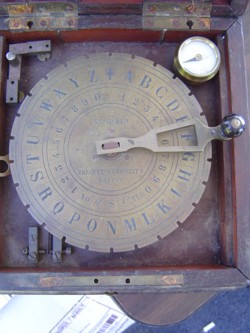 |
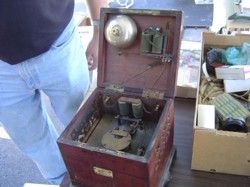 |
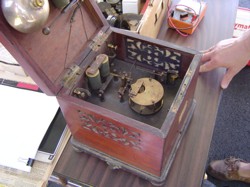 |
Charles T. Chester Dial Telegraph Set -- 1862 Patent
France was not the only country making dial telegraph sets. Charles T. Chester (New York) made this interesting dial set in 1862. The mechanism works differently than the French designs. For one, each unit can be used for both transmitting and receiving. Also, the receiver runs off a spring wound clockwork mechanism. The Chester dial telegraph also had a small telegraph key attached to the side of the unit so that standard Morse Code could be sent as well. You can see the original 1862 patent by clicking here.
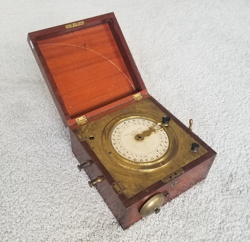 |
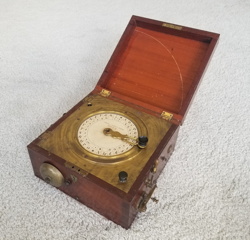 |
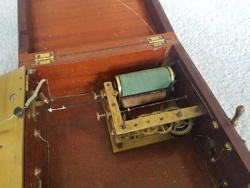 |
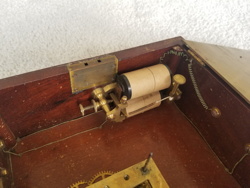 |
Chester Dial Telegraph Set -- 1863 Patent
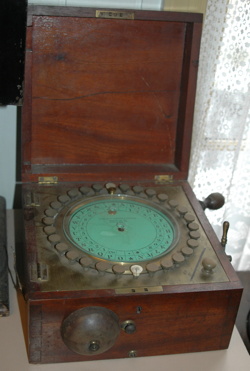 |
Another Dial Telegraph set by Charles Chester. This version was patented in 1863 and had push buttons around the perimeter of the dial to send letters and numbers. (US Patent #40324) |
The Beardslee Dial Telegraph
In December 1859, George W. Beardslee patented this portable dial telegraph set. It was designed to be used by the Army as a field telegraph set. This was called the Beardslee Electro Magnetic Military Telegraph. The Beardslee Telegraph was powered by a hand-cranked magneto built into the box, so there was no need to carry around heavy acid-filled batteries. The set had a range of about 10 miles. It was first deployed in May 1862 by the Union Army during the Peninsula Campaign in SE Virginia.
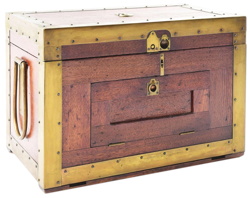 |
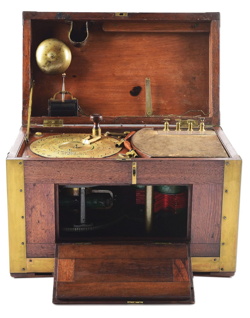 |
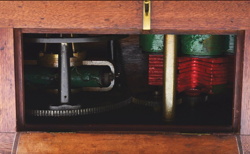 |
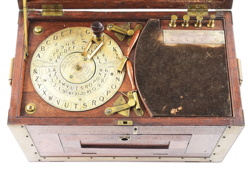 |
Johnson & Whittemore Dial Telegraph
This table mounted dial telegraph set was patented by John B. Johnson and Harrison Whittemore on August 27, 1872. It was based on an earlier patent by Thomas Hall from June 11, 1867. The unit was powered by a foot treadle that operated a magneto, thus eliminating the need for wet cell batteries. The set was primarily used on private line systems.
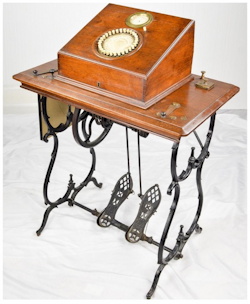 |
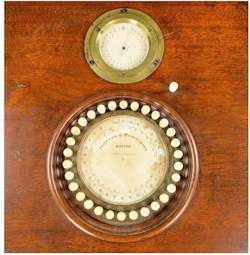 |
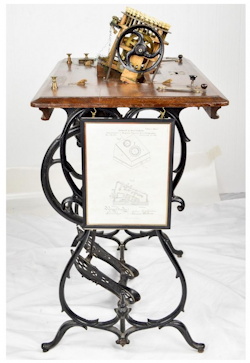 |
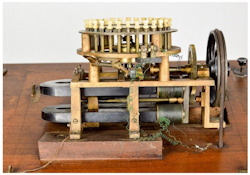 |
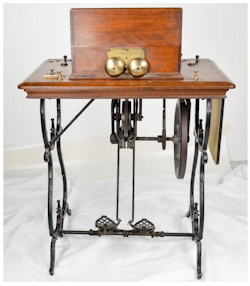 |
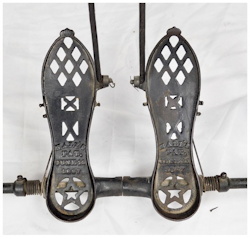 |
Wheatstone ABC Telegraph
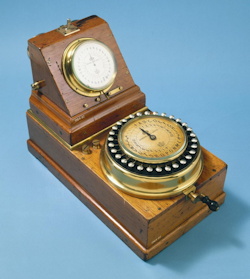 |
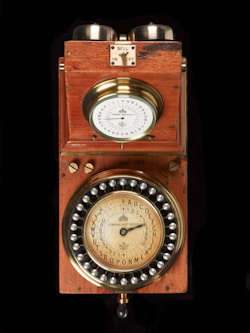 |
Patented by Charles Wheatstone and William Fothergill Cooke in 1840, the Wheatstone ABC Telegraph was actually the first dial telegraph, pre-dating the French designs. Letters and numbers were selected by pressing small levers that were arranged around the perimeter of the lower dial. (Science Museum Group collection: sciencemuseumgroup.org.uk)
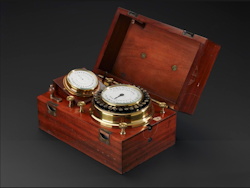 |
A Portable Wheatstone ABC Telegraph Set. (Science Museum Group collection: sciencemuseumgroup.org.uk) |
Unknown Dial Telegraph Transmitter (Please Contact Me if You Have Information About This Set)
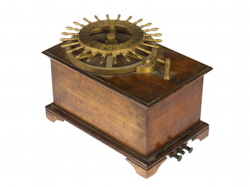 |
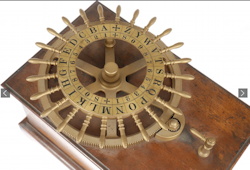 |
Many companies made dial telegraph demonstration sets, which were sold as toys or to be used to demonstrate the principle of dial telegraphy:

